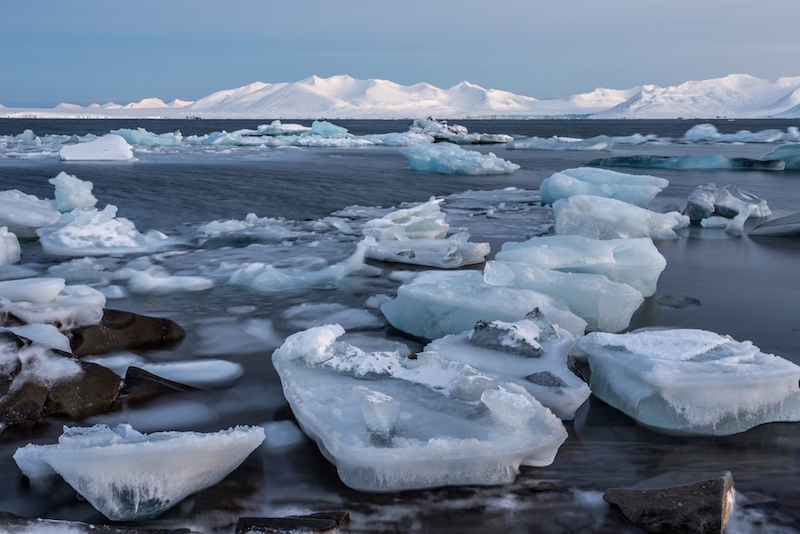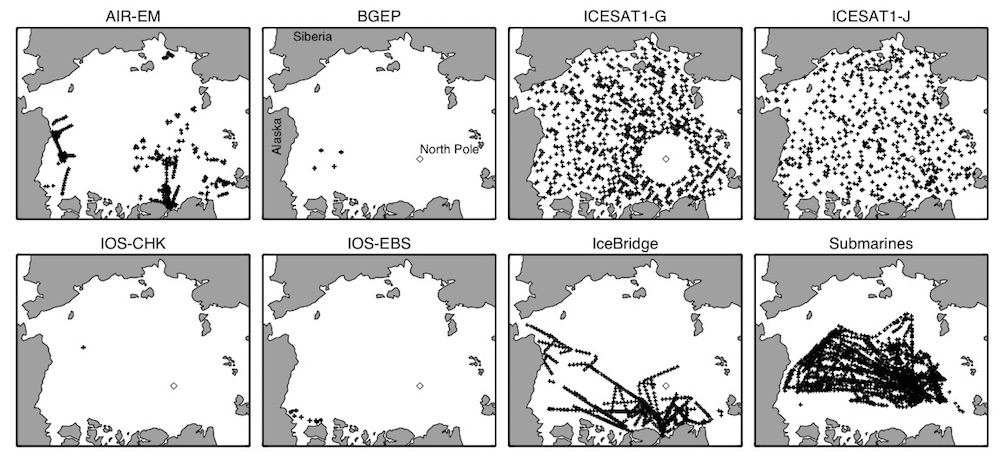Arctic Sea Ice 'Thinning Dramatically,' Study Finds

Arctic sea ice — the ice that freezes and floats on Arctic waters — is thinning at a steadier and faster rate than researchers previously thought, a new study finds.
Using modern and historic measurements, the researchers got an extensive view of how the thickness of Arctic sea ice has changed over the past few decades. According to measurements from multiple sources, the ice in the central Arctic Ocean thinned 65 percent between 1975 and 2012, from 11.7 feet (3.59 meters) to 4.1 feet (1.25 m).
The thinning is even steeper for September sea-ice levels, when sea ice is at its lowest after the summer melt. During the same 37-year stretch, September ice thickness thinned 85 percent, or from 9.8 feet (3.01 m) to 1.4 feet (0.44 m). [On Ice: Stunning Images of Canadian Arctic]
"The ice is thinning dramatically," said lead researcher Ron Lindsay, a climatologist at the University of Washington (UW) Applied Physics Laboratory. "We knew the ice was thinning, but we now have additional confirmation on how fast, and we can see that it's not slowing down."
The study may help researchers gauge when the Arctic Ocean will be ice-free during parts of the year, he added.
The researchers acquired the data from a number of different sources, making them the first to combine all available observations on Arctic sea-ice thickness into one study. For instance, from 1975 to 1990, most ice-thickness readings were from under-ice submarines. These vessels once used sonar to measure ice drift so they could figure out where they could safely surface.
The submarine data suggest that from 1975 to 2000, the Arctic sea ice thinned 36 percent, a little less than half of what the new study found, the researchers said.
Get the world’s most fascinating discoveries delivered straight to your inbox.
"This confirms and extends that study," Lindsay said. The larger data set used in the new study shows that the leveling off of sea ice thinning in the 1990s was only temporary, he said.
Since 2000, readings are largely based on airborne and satellite measurements — such as NASA's IceSat satellite and IceBridge aircraft — and other methods that involve people directly measuring the ice thickness.
Data dump
All of the data in the study are now in the Unified Sea Ice Thickness Climate Data Record, which gets as many as 50,000 new measurements a month. The record is curated by researchers at the University of Washington, and stored at the U.S. National Snow and Ice Data Center.
Lindsay also works with a UW group who puts together a popular calculation of monthly sea-ice volumes that blends weather data, sea-surface temperatures and satellite measurements of sea-ice concentration for ice thickness maps, the researchers said.
Critics have said those calculations of ice loss seemed too rapid, and questioned their value, the researchers said. But the new study shows the ice may be thinning at an even faster rate than the calculations showed, the researchers said.
"At least for the central Arctic basin, even our most drastic thinning estimate was slower than measured by these observations," said co-researcher Axel Schweiger, a polar scientist at the UW Applied Physics Laboratory.
The new study also shows that hands-on ice-measuring methods used by people on the ground are just as accurate as other methods, Schweiger said.
"Using all these different observations that have been collected over time, it pretty much verifies the trend that we have from the model for the past 13 years, though our estimate of thinning compared to previous decades may have been a little slow," Schweiger said.
The data in the new study goes up to 2012, when summer sea-ice levels dropped to a record low. Since then, ice levels have slightly increased, the researchers said.
"What we see now is a little above the trend, but it's not inconsistent with it in any way," Lindsay said. "It's well within the natural variability around the long-term trend."
The findings were published in the March issue of the journal The Cryosphere.
Follow Laura Geggel on Twitter @LauraGeggel. Follow Live Science @livescience, Facebook & Google+. Original article on Live Science.

Laura is the managing editor at Live Science. She also runs the archaeology section and the Life's Little Mysteries series. Her work has appeared in The New York Times, Scholastic, Popular Science and Spectrum, a site on autism research. She has won multiple awards from the Society of Professional Journalists and the Washington Newspaper Publishers Association for her reporting at a weekly newspaper near Seattle. Laura holds a bachelor's degree in English literature and psychology from Washington University in St. Louis and a master's degree in science writing from NYU.



